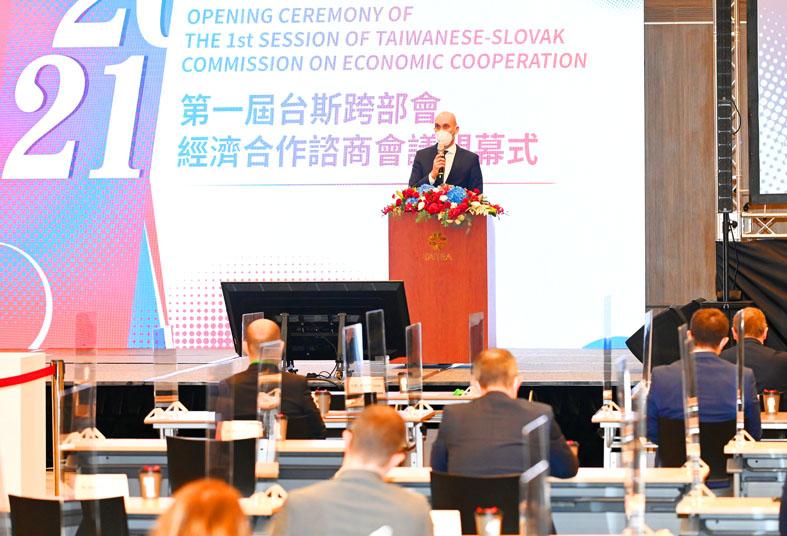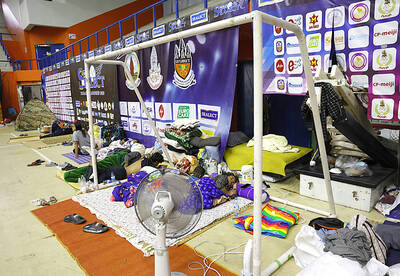Taiwan and Slovakia are headed for closer trade relations, Slovak Second State Secretary of the Ministry of Economy Karol Galek said yesterday at the Taiwanese-Slovak Commission on Economic Cooperation meeting in Taipei.
Taiwan and Slovakia’s cooperation during the COVID-19 pandemic proves the countries’ ability to work together as equal partners “in good times and the bad,” and Slovakia is ready to work with Taiwan as “small but open economies” to “find our place in an ever-changing global economy,” Galek said.
“I believe that [the meeting] will bring far-reaching discussions, allowing both sides to make the best of their economic potential for future cooperation,” he said.

Photo: Tien Yu-hua, Taipei Times
Galek said he met with National Development Council (NDC) Minister Kung Ming-hsin (龔明鑫) early yesterday, when they discussed specific areas of potential cooperation, including on smart cities, space industries, electric vehicles and semiconductors.
Both sides agreed to create a working group to explore areas of cooperation in research and development, among other fields, he said.
“Slovakia supports Taiwan,” said Galek, who is leading a delegation of 18 senior officials and 25 businesspeople from Slovakia.
Kung, who led a 66-member delegation to Slovakia in October, when seven memorandums of understanding were signed, said that Slovakia and Taiwan should deepen trade relations.
“As Taiwan and Slovakia are both free, democratic partners with shared values, we have signed agreements since establishing offices in each other’s countries to avoid double taxation, foster technology cooperation, the establishment of e-government services, economic cooperation, working holidays and many other topics,” Kung said.
Trade between the countries has grown rapidly and Slovakia receives the second-highest investment from Taiwan among EU countries at 500 million euros (US$564.64 million), creating 3,000 Slovak jobs.
“After visiting Slovakia in October, many Taiwanese companies are willing to increase their investments in Slovakia,” Kung said.
Taiwan’s donation of masks to Slovakia in the early days of the COVID-19 pandemic and Slovakia’s later donation of 160,000 vaccines to Taiwan formed the basis of trust between the two nations, he said.
“The mutual donations became what President Tsai Ing-wen (蔡英文) described as a ‘circle of good,’” Kung said.
“We hope that this circle can be extended to the economic realm,” he said.
Director-General of Economic and Development Cooperation at Slovakia’s Ministry of Foreign Affairs Lucia Kiss said in her opening address that the talks “open a wave of active and direct consultations between the ministries of both countries, and it is an important historic event in our bilateral relations.”
That the Slovak delegation decided to visit Taiwan despite the COVID-19 pandemic shows that Slovakia is determined to “deepen and upgrade economic relations with Taiwan,” she said.
Yesterday’s opening ceremony was also attended by Deputy Minister of Foreign Affairs Tien Chung-kwang (田中光) and Deputy Minister of Economic Affairs Chen Chern-chyi (陳正祺).
The Slovak delegation is visiting Taiwan until Friday.
Additional reporting by CNA

The US government has signed defense cooperation agreements with Japan and the Philippines to boost the deterrence capabilities of countries in the first island chain, a report by the National Security Bureau (NSB) showed. The main countries on the first island chain include the two nations and Taiwan. The bureau is to present the report at a meeting of the legislature’s Foreign Affairs and National Defense Committee tomorrow. The US military has deployed Typhon missile systems to Japan’s Yamaguchi Prefecture and Zambales province in the Philippines during their joint military exercises. It has also installed NMESIS anti-ship systems in Japan’s Okinawa

‘WIN-WIN’: The Philippines, and central and eastern European countries are important potential drone cooperation partners, Minister of Foreign Affairs Lin Chia-lung said Minister of Foreign Affairs Lin Chia-lung (林佳龍) in an interview published yesterday confirmed that there are joint ventures between Taiwan and Poland in the drone industry. Lin made the remark in an exclusive interview with the Chinese-language Liberty Times (the Taipei Times’ sister paper). The government-backed Taiwan Excellence Drone International Business Opportunities Alliance and the Polish Chamber of Unmanned Systems on Wednesday last week signed a memorandum of understanding in Poland to develop a “non-China” supply chain for drones and work together on key technologies. Asked if Taiwan prioritized Poland among central and eastern European countries in drone collaboration, Lin

Renewed border fighting between Thailand and Cambodia showed no signs of abating yesterday, leaving hundreds of thousands of displaced people in both countries living in strained conditions as more flooded into temporary shelters. Reporters on the Thai side of the border heard sounds of outgoing, indirect fire yesterday. About 400,000 people have been evacuated from affected areas in Thailand and about 700 schools closed while fighting was ongoing in four border provinces, said Thai Rear Admiral Surasant Kongsiri, a spokesman for the military. Cambodia evacuated more than 127,000 villagers and closed hundreds of schools, the Thai Ministry of Defense said. Thailand’s military announced that

NO CONFIDENCE MOTION? The premier said that being toppled by the legislature for defending the Constitution would be a democratic badge of honor for him Premier Cho Jung-tai (卓榮泰) yesterday announced that the Cabinet would not countersign the amendments to the local revenue-sharing law passed by the Legislative Yuan last month. Cho said the decision not to countersign the amendments to the Act Governing the Allocation of Government Revenues and Expenditures (財政收支劃分法) was made in accordance with the Constitution. “The decision aims to safeguard our Constitution,” he said. The Constitution stipulates the president shall, in accordance with law, promulgate laws and issue mandates with the countersignature of the head of the Executive Yuan, or with the countersignatures of both the head of the Executive Yuan and ministers or